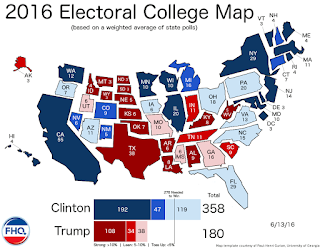THE BIG IDEA:
One in five voters in 2012 were college-educated white women. Mitt Romney won
them by six points, according to exit polls.
Our fresh
Washington Post-ABC News Tracking Poll, which has Hillary Clinton ahead by just
two points among all likely voters nationally, finds that Donald Trump is
losing college-educated white women by 27 points.
 If the
Republican nominee were anywhere close to Romney’s 52 percent support level
among this traditionally Republican-leaning constituency, he would likely win
the election. But drilling into the crosstabs of our polling and reviewing
credible, state-level data demonstrate how highly unlikely it is that this
constituency will waver in the final days. It is one of the reasons that, even
though the race has tightened pretty dramatically, Clinton retains a significant
structural advantage.
If the
Republican nominee were anywhere close to Romney’s 52 percent support level
among this traditionally Republican-leaning constituency, he would likely win
the election. But drilling into the crosstabs of our polling and reviewing
credible, state-level data demonstrate how highly unlikely it is that this
constituency will waver in the final days. It is one of the reasons that, even
though the race has tightened pretty dramatically, Clinton retains a significant
structural advantage.
The gender gap
is nothing new. Democrats tend to perform exceptionally well with unmarried and
minority women. A Pew study in July found that there was no difference in
candidate support between men and women in 1972 and 1976, but since 1980 women
writ large have preferred Democratic presidential candidates by an average of
eight points.
Our national
tracking polling shows that the race has moved back toward something close to
this historic norm. Men prefer Trump by 11 points (51-40) and women prefer
Clinton by 11 points (52-41).
Clinton is
ahead only 11 points among women overall because Trump is running up his margin
among white women without college degrees. They favor him by 28 points, 61
percent to 33 percent, despite the dozen women who have now come forward
publicly to accuse him of sexual misconduct.
But the
preference for Clinton among college-educated, white women matters a great deal
because they habitually turn out to vote at higher rates than almost every
other group of voters, including less-educated women. So, in an election with
lagging enthusiasm, this constituency packs a bigger punch.
 Donald Trump is
busy building his Cabinet and planning his agenda, but he isn't really,
officially going to be President quite yet. One of the peculiarities of
American democracy is that it's actually a group of 538 "electors" --
members of the Electoral College -- in this nation of 318 million who actually
pick the president.
Donald Trump is
busy building his Cabinet and planning his agenda, but he isn't really,
officially going to be President quite yet. One of the peculiarities of
American democracy is that it's actually a group of 538 "electors" --
members of the Electoral College -- in this nation of 318 million who actually
pick the president.


